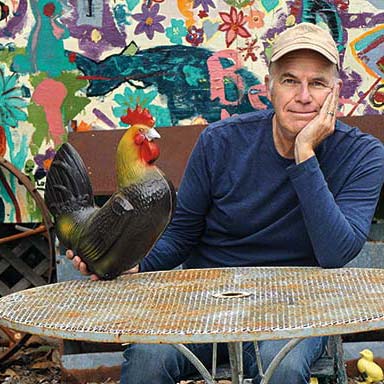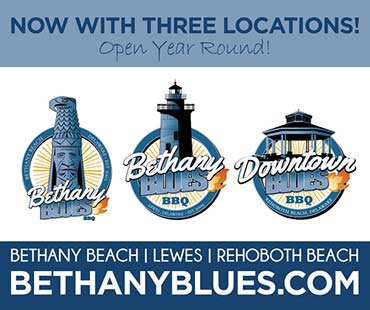
A day of deliberate wrong turns makes everything right
By Bill Newcott | Photograph by Carolyn Newcott
From the April 2020 issue

For the seasoned traveler, there’s nothing better than getting lost. If you never get lost, you never discover anything.
Alas, getting lost isn’t as easy as it sounds — particularly if you’re determined to get lost in the place where you live. There are street signs everywhere. Familiar landmarks keep popping up. And you have to resist the urgent temptation to switch on your GPS, “just to see.”
Despite the challenges, I was determined to get lost in coastal Delaware for a whole day; to explore unfamiliar back roads; to meet people who didn’t know anybody I knew. And so one recent morning I kissed my wife farewell, hopped into my car, and set out to get utterly disoriented.
Of course, even getting lost requires ground rules. I decided on a specific starting point and a final destination, to reduce the chances of just driving around in circles all day. Point A would be the Fenwick Island Lighthouse, hard up against the Delaware/ Maryland border. Point Z would be Cape Henlopen, site of the Fenwick light’s long-lost sister, the beacon that fell from its sand dune pulpit in 1926.
As for my random route, from Fenwick
I would improvise a wide westward loop around the area’s inland waterways.
Most importantly, I brought up the GPS function on my iPhone and swiped it away. Gone. No familiar voice telling me where to turn. No scrolling dashboard map.
I smiled smugly.
“This is how Daniel Boone must have felt,” I thought, sipping hazelnut coffee from my travel mug.
I start at the lighthouse
I am standing at the foot of the whitewashed Fenwick Island light, craning to see the black lantern room, eight stories above.
Actually, I’m standing in Maryland. The Delaware state line, inches north of the sidewalk, is defined by a low white monument, placed here on April 16, 1751. The Maryland side of the monument bears the familiar diamond-and-cross design of the Calvert family coat of arms. The Penn family crest on the Delaware side recalls when the state was still part of Pennsyl-vania. Happily, in 1776 nascent Delawareans simultaneously declared their independence from both King George III and Pennsylvania — lest they someday refer to submarine sandwiches as hoagies and say things like “Yinz go’n to the Steelers game, yah?”
This monument tells me exactly where I am. That will not do.
There’s only one route west out of Fenwick Island: Lighthouse Road, also called Route 54.
I cross the bridge over The Ditch, a canal that
separates Little Assawoman Bay from her sister,
Big Assawoman Bay.
I live up near Lewes, where a favorite parlor game is to come up with creative profane names for the developers who’ll tear down a forest, evict all the animals and rechristen the place “The Preserve.” We tend to think enviously of less-developed Fenwick and its environs, but my neighbors would be shocked at the amount of building going on down here. Everywhere I look, communities are springing up; field after field of “stick-built” homes (a term that makes me imagine Little Pig construction crews).
Nevertheless, I’ve never been along this stretch of road before. I’m not quite lost yet, but I’m at least exploring the unknown.
I try to get lost
Not far up the road, even at 35 mph, I am aware of eyes watching me. I glance to the left and stare back at the faces peering from the windows of Sound United Methodist Church.
It’s a century-old building in the style of so many country churches around here, but Sound Church has one distinctive feature: an array of gloriously colorful stained-glass windows, each combining the Old World art of colored glass with a decidedly folk-art-inspired design. Angels cavort, Jesus extends his hands over the faithful. The colors are bold, the figures flat, like subjects of a Grandma Moses painting.
I’m barely five miles out of Fenwick and already my wanderings are rewarding me.
A bit farther along, I hang a random left on Williamsville Road. It’s winding and grows narrower by the half-mile. I pass an abandoned chicken house with three turkey vultures on the roof, waiting for the welcome whiff of a rotting carcass. In an empty field I spot a miniature concrete lighthouse, maybe 15 feet tall, seemingly awaiting someone to build a miniature golf course around it. Today I’ll spot dozens of lawn lighthouses, persistent reminders that although I’m surrounded by farmland, the sea is never far away.
The pavement becomes rougher. I’ll later learn this is the point where Williamsville Road dips briefly into Maryland — its name changing ironically to Delaware Road — before looping back into the First State. I seem to be pushing deeper and deeper into a bayside wilderness. I couldn’t be happier.
Then I make a turn, and my illusions of remote wild lands are shattered. Spreading before me, like a stick-built Oz, stands the sprawling Bayside development, home of the Freeman Stage.
A bit deflated, I drive to the end of the property, where a poolside restaurant overlooks Big Assawoman Bay. Across the water, seemingly close enough to touch, are the towering condos of Ocean City.
I’m not lost at all.
I find the Land of Lost RVs
You don’t pass up a street called Bearhole Road. So I turn onto it, keeping a hopeful lookout for bears, or the holes that contain them.
A mile or so in I find something almost as good: a lineup of life-size plywood cartoon figures atop a low hill. There’s a smiling guy in what may be blue bathing trunks carrying what looks like a hatchet. He’s running away from an angry blond woman wielding a roller pin, and she’s followed by several other amused characters, including a child pulling a dog.
Behind this odd crew stretches a long red chicken barn — a “chicken house,” in local parlance — surrounded by lots of RV campers. And on the roof, in letters large enough to be seen by passing aircraft, are the words: “Lost Lands RV Park — Where Country Meets the Beach.”
I pull into the gravel drive and park at the near end of the building. The structure is enormous, stretching toward a vanishing point like the work of a young artist just getting the hang of depicting perspective.
“It’s 500 feet long,” says David Simpson, the friendly owner of Lost Lands and the closest thing to a mayor for this collection of 179 motor homes. He’s been running the place for 19 years.
“It was an abandoned chicken farm,” says Simpson, a bearded, ball-capped native of the area. “No one was looking after it. We had to clear off the hog pens and the tractors and the old cars.”
Simpson is especially proud of his renovation of the chicken house, nearly long enough to contain a horizontal Washington Monument. Aside from an international airport terminal or cathedral, you don’t often step into a long, unobstructed enclosed space like this. There are picnic tables for its entire length — a place for the RV park residents to dine and, perhaps, create a small sense of community. The interior is decorated with old road signs and other whimsical touches, including an array of mounted bedpans.
Simpson tells me he didn’t expect to become an RV park impresario; he stumbled upon this place completely by accident.
“I’m just one of those guys who likes to go out on the back roads and see what’s there,” he says. “I like to not just see things, but look through things, and envision what they could be.”
Then he smiles.
“Like you,” he says.
Bearhole Road has been good to me, so I continue on it straight to the end.
I flip a coin, make a few random turns, and end up on the wonderfully named Gum Road.
That’s when I see the horse. I think it’s a Clydesdale, but who am I kidding? I know horses like I know quantum physics. Maybe less. But I have to pull over to admire his striking coat and four white “socks.” His long blond mane is a torrent of hair spilling over his shoulders, nearly to his knees.
I pull over to take a picture of him grazing. But the moment I raise my camera, he lifts his head to stare at me.
“I don’t want a portrait — I want a candid!” I mutter. But he stares me down until I leave.
I meet the Redmen
I head west on Gum Road, named for the family of 17th century farmer Roger Gum, whose genetic line nearly 250 years later yielded a Minnesota girl named Frances Gumm — better known to you and me as Judy Garland.
I pass farmhouses with cars parked on the grass and solitary houses built on lots that were covered with corn not long ago. Just outside of downtown Selbyville I spot a sign for Cemetery Road.
It probably says a lot about me when I say my idea of a good time is exploring an old cemetery. In Selbyville Redmen’s Cemetery I spot the final resting place of John Townsend Jr., who was governor of Delaware until 1921 (and later a U.S. senator).
The cemetery is named for the Red Men, a fraternal group still in existence but much in decline — and what fraternal group isn’t? — that traces its origins back to the Boston Tea Party (in which white Colonists disguised themselves as “red men” to protest British tea taxes). There are Red Men cemeteries like this one — and Redmen’s, as spellings vary — across the country.
For some time Selbyville’s chief claim to fame was the old Mumford Sheet Metal Works, which in 1950 produced the world’s largest frying pan. And Doyle’s Restaurant, circa 1930s, is said to be the oldest operating diner in Delaware. These days the town’s biggest employer has to be Mountaire Farms. It is lunchtime, and I can easily spot workers from the chicken processing plant, still wearing their gauzy hairnets. One such couple is walking across Church Street. She is clearly trying to stay one step ahead of him; he’s trying to keep up without looking like he’s actually chasing her.
“You want some of this ice cream cone?” he’s yelling, and I can see he’s waving a vanilla cone in the air. “You want a bite of this?”
She picks up her pace. “I don’t want none of that ice cream cone now!” she shrieks without turning her head. “Not now I don’t!”
“Here!” he bellows, desperation rising in his voice. “Take a bite! Take the whole thing! The whole thing!”
She stops and spins in his direction.
“You idiot!” she sobs. “This is not about the ice cream cone!”
Even I knew that.
It’s clearly going to be a long afternoon at the Mountaire Farms chicken processing plant on this day.
I traverse the Great Plains
Pepper Road out of Selbyville heads north. Along this stretch of farmland, more than a few families seem to be having yard sales of the most unorganized kind: items from toasters to encyclopedias strewn about on blankets and dropcloths.
It’s about 5 miles from Selbyville to Frankford, and unlike the shore communities, which all seem to blend into each other, the gaps between towns make the landscape here feel positively Midwestern.
That Great Plains vibe only grows more vivid as I turn onto Main Street in Frankford. At one end of the thoroughfare stands the spire of the 167-year-old Frankford United Methodist Church — its slender silhouette seemingly entangled in the towering grain elevators of yet another Mountaire facility. The Cathedrals of the Midwest, they call grain elevators out there, and at this moment I could just as easily be sitting outside Lincoln, Neb., as in Slower Lower Delaware.
I leave town, heading northeast on Murray Road, and suddenly I am in horse country. Beyond the low houses on my left I can see oval tracks with red-coated thoroughbreds grazing at their centers.
Seemingly in a flash, I’ve traveled from America’s breadbasket to the bluegrass of Kentucky.
I encounter a rocket ship
It’s one thing to get lost; it’s quite another to shift space/time. One moment I’m trying to find my way through Dagsboro — the next I’m blinded by the afternoon sun glinting off a sleek silver rocket ship. Squinting into the light, I see the craft is sailing across the front lawn of a large century-old house.
The rocket is a piece of art, it’s for sale, and that goes for everything inside and outside the fanciful jumble that is Jayne’s Reliable, where a quick glance around reveals choice offerings including a bronze mermaid, some rusting vintage gas station signs, and an ancient doctor’s office scale.
“Yeah, the rocket gets a lot of people in,” says Karen Jayne, who came to Dagsboro with her husband, David, to start the business about eight years ago.
“We’d always done other things for a living, but our idea of a good date was always going to a yard sale. We have three grown sons, and we always preached to them, ‘Do what you love.’ Finally, we decided to follow our own advice.”
The Jaynes are purebred collectors — they leave the curating to their customers. So you can find that church pew, 8mm film projector, or Coastal Highway street sign you’ve been looking for. Why you want it, and what you do with it, is nobody’s business but yours.
I find New England
I’m threading the needle between Dupont Boulevard, also known as Route 113 — as far west as I’m willing to go — and the upper reaches of the Indian River on Iron Branch Road, which becomes State Street. There’s no way to be lost here, but as I approach Main Street in downtown Millsboro, I realize I’ve never crossed it and continued north. So I head that way, staying on State Street — and am almost immediately rewarded with one of the loveliest stretches of road in all of coastal Delaware.
It begins where State Street becomes Betts Pond Road, a point announced by the presence of a stately yet crumbling wood house and the equally mature small barn behind it. The road enters a tunnel of trees, the pines on the left standing between the pavement and a long, meandering pond. I open my window at the start and soon hear the music of water spilling over a low dam. Even on this, the most brilliant of sunlit days, Betts Pond Road is a shrouded oasis of dense trees, sparkling water, and cool breezes.
If there is any disappointment in Betts Pond Road, it’s that this magical length stretches for less than a quarter mile. I turn around and drive it again, and then again, soaking in its gentle curves and shadowy mysteries, reminded of much-longer childhood drives along twisting, narrow roads hugging the shores of New Hampshire lakes.
Delaware returns presently, and now I’m heading north on Patriots Way. I know I need to head east if I’m ever going to find Cape Henlopen.
An ascending plane warns me that I’m getting perilously close to the Georgetown Airport — which makes me as un-lost as I can imagine. Suddenly, crossing Gravel Hill Road, I notice something I’ve never seen before: a little road peeling off to the left. It’s Anderson Corner Road.
The way is pleasingly shaded by forest, inhabited by the occasional ranch house homestead. Pretty soon I spot the delightfully narrow Doddtown Road. It’s the best kind of Delaware road: the kind that doesn’t even have a center line.
I turn left onto Doddtown, lost again at last.
I’m enjoying this new landscape so much I nearly miss a startling sight to my left: a vast field of trees growing under an equally sprawling series of plastic canopies and arcing PVC frames. I veer off the road and roll past a sign that reads “Shady Oak Farm: Est. 1985.”
Each section of the canopied forest is populated by a different kind of small tree or shrub. I can’t name any of them, of course, but I recognize them from virtually every yard in front of every house within 20 miles of here.
As I pull up to the office, a friendly guy named Mike hops off a tractor.
“We’ve got about 22 acres under cover,” he says. “It’s mostly nuts and bolts shrubbery. Nothing fancy.
“Let me show you something,” he says, leading me to a low building at the rear of the property. We push through the door — and before me spread countless tiny plants on tables, shelves, and the floor. This is the cutting room, where baby plants are nurtured year round.
“We’ve got about 25,000 cuttings in here,” says Mike.
In other words, if you own a house in coastal Delaware, chances are your crepe myrtle, holly bush, or English yew started as a sprig in this room.
I am lost no more
I head east and find myself on Harbeson Road. Try as I might, I cannot get lost again. The closer I get to the beaches, the more that familiar traffic arteries course through the sprouting communities.
Still, I’ve set out to go from lighthouse to lighthouse, so I maneuver through Five Points, traffic along Savannah Road, and wind my way through Cape Henlopen State Park.
Not even the sand outcropping that so inefficiently supported the Cape Henlopen beacon remains today. It’s a reminder that, if you wait long enough, even the sturdiest of landmarks can fade away in a single lifetime. A rotting barn, a fallen oak tree, a vanished field or an extinct strip mall, all are agents of change by subtraction.
So there’s hope yet — hope that after years of living with the constant change that defines coastal Delaware, we may still be able to roam those meandering back roads, and get lost.



